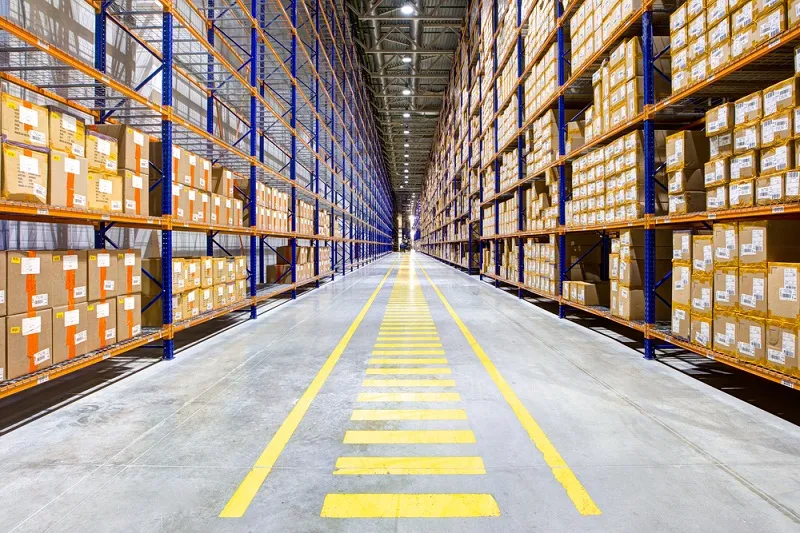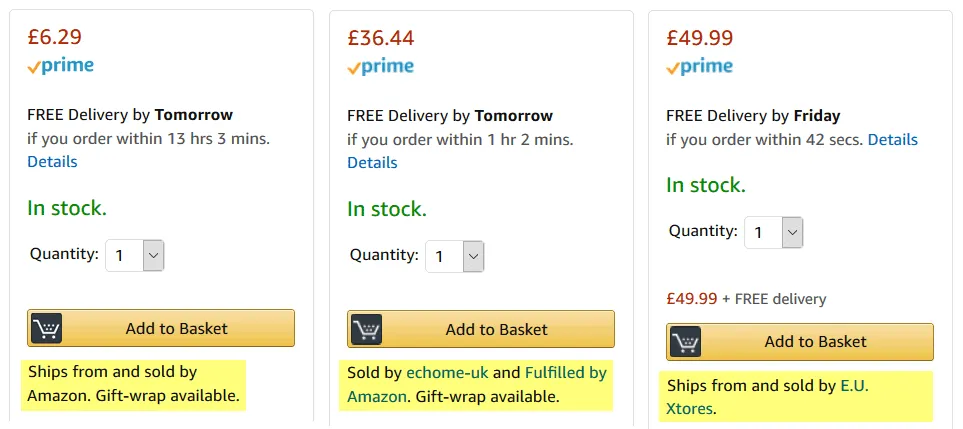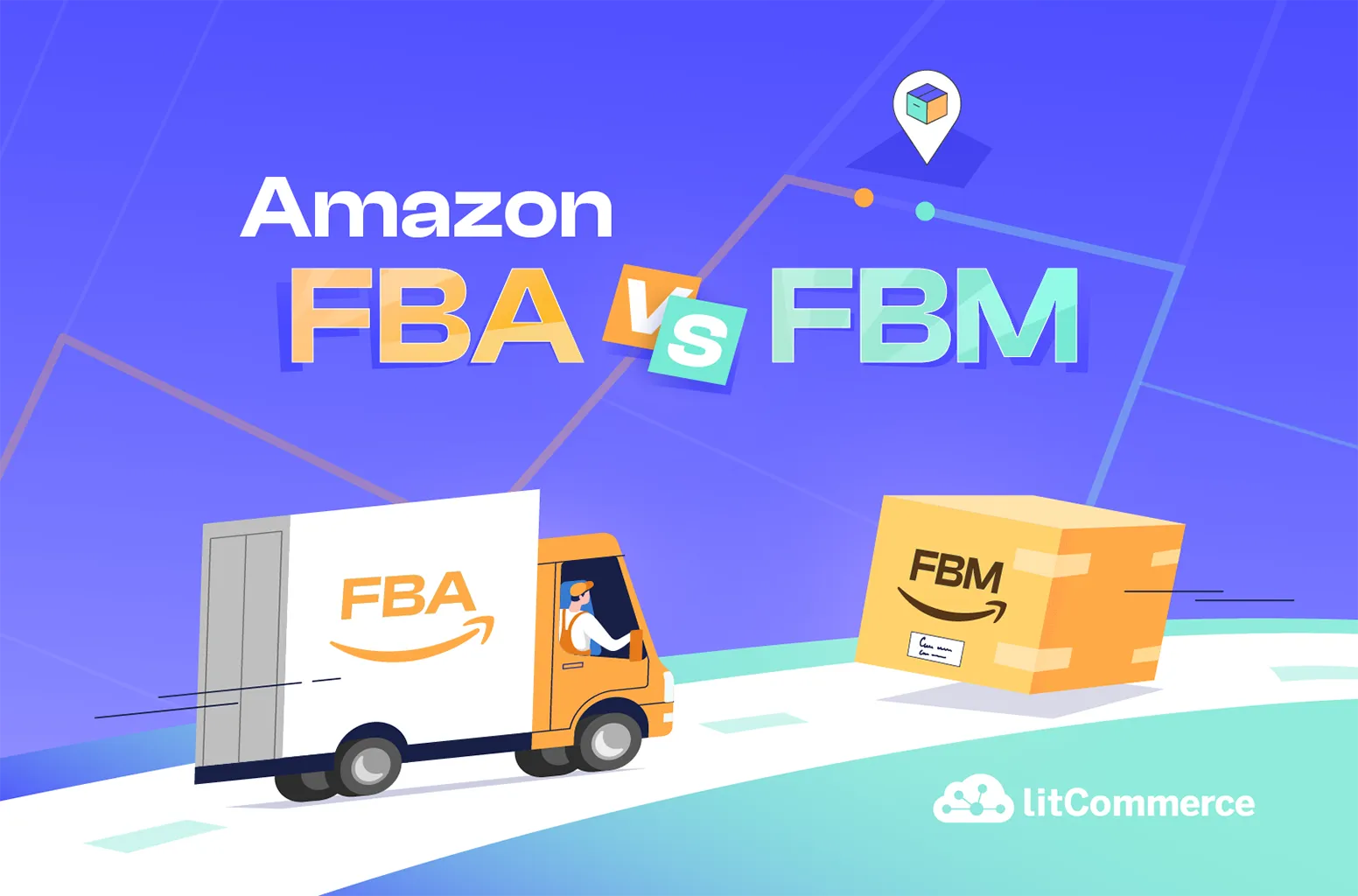Choosing the optimal fulfillment between Amazon FBA and FBM needs many considerations. According to Jungle Scout, 86% of Amazon sellers use FBA, and 32% of Amazon sellers use FBM.
Both options have benefits and drawbacks. Hence, sellers must understand the differences between the two fulfillment methods to determine which best suits their business needs.
This article will cover the following key points of Amazon FBA vs FBM: A head-to-head comparison. But first, here are some key takeaways:
- FBA – Fulfillment by Amazon is Amazon’s service that helps sellers handle every step of the fulfillment process, including picking, packing, and shipping.
- FBM – Amazon FBM means fulfilled by merchant, enables sellers to list their products on Amazon and fulfill orders themselves
- There are 6 main factors when choosing the best fulfillment: product weight and dimension, level of customer support, fees, shipping demands, and more.
Learn to Sell on Amazon with LitCommerce
Do you already have a web store, it would take just ONE click to sell on Amazon with LitCommerce! List all your products in one go!
Amazon FBA vs FBM: Quick Comparison!
Deciding which method to choose can be difficult if you don’t understand the pros and cons of each program. Before getting started, let’s take a look at the main difference between these 2 fulfillments: Amazon FBM vs FBA. Then, here is some advice to help you choose the right fulfillment methods:
# | Pros | Cons |
FBA | - Access to Amazon Prime customers. | - Higher FBA fees: Amazon fulfillment fees and inventory storage fees. |
FBM | - More control over the fulfillment process. - Direct customer interaction | - Less chance of winning Buy Box |
After going through every difference between FBA and FBM. If you are still feeling overwhelmed by the Amazon fulfillment options. Below is our advice on choosing between FBA and FBM to help you choose the right model for your business:
FBA is a better choice for you if:
- You have high-volume sales and high profit margins: The FBA fees can be offset by the increased sales and potentially faster shipping times that come with Prime eligibility.
- You want to focus on selling and not fulfillment: FBA frees you up to concentrate on marketing and product development.
- You want a competitive edge: Prime free shipping and Buy Box placement can significantly boost sales.
FBM is a better choice for you if
- You have low-volume sales or low-profit margins: The FBA fees could eat into your profits significantly.
- Customization is important: You have more control over packaging and branding with FBM.
- You have the resources to manage fulfillment: You and your team will need to handle storage, shipping, customer service, and returns processes.
Plus, here are some additional factors to consider:
- Product size and weight: FBA fees are often higher for bulky or heavy items. FBM might be more cost-effective for these products.
- Inventory management: If you have limited storage space, FBM might be a better option, as you can control inventory levels more closely.
- Your experience: If you’re new to eCommerce, FBA can be easier to manage as Amazon handles many aspects of the fulfillment process.
For a more detailed explanation of the question: “What is FBA Amazon vs FBM?”, keep reading the following parts.
Understanding Amazon FBA – Breakdown Pros and Cons
FBA, or “Fulfillment by Amazon,” is an Amazon fulfillment method that helps sellers handle every step in the fulfillment process. Sellers send their products to Amazon’s warehouses. When an order is placed, Amazon handles the product’s picking, packing, and shipping to the customer. Amazon also takes customer service and returns.
Is Amazon FBA worth it in 2024? Of course, the answer is yes. Amazon FBA remains a popular choice, with over 86% of sellers choosing it.
FBA also provides Amazon FBA private labels, which is a combination of Amazon FBA and private labeling, allowing you to create your brand with your own logo, name, and product design.
Pros of FBA
After answering the question “What is Amazon FBA vs FBM”, why don’t we discover the pros of Amazon FBA? Here are 6 main reasons why you should use Amazon FBA.

#1. Access to Amazon Prime customers.
By listing your products with FBA, you can access approximately 100 million Amazon Prime subscribers in the US alone. These Prime members shop more often, spend more annually, and constitute half of Amazon’s customer base.
Your products will also qualify for Amazon Prime’s free two-day shipping. By leveraging Amazon Prime, you are likely to increase sales and enhance profitability, benefiting from the trust and reach of the Amazon brand.

#2. Free and fast shipping service for customers.
Items fulfilled through FBA are eligible for Prime shipping. This can significantly increase your sales potential, as many customers prioritize fast and free shipping when making buying decisions. Even for non-Prime members, FBA’s efficient network often translates to quick delivery within a few business days.
Free and fast shipping eliminates the hassle and expense of additional shipping costs for customers. This can make the entire shopping experience smoother and more appealing. In addition, customers receive their purchases quicker, leading to higher satisfaction and a greater chance they’ll return for future purchases.
#3. Higher chance to win Buy Box.
The holy grail of Amazon listings is the Buy Box. This prominent placement on product pages is where the majority of customer purchases happen. FBA offers a significant advantage in securing this prime spot. Amazon’s algorithm prioritizes FBA products when awarding the Buy Box due to several factors. FBA sellers consistently deliver fast and reliable shipping, which is a key customer buying factor.
Additionally, FBA eliminates fulfillment errors and ensures on-time deliveries, boosting customer satisfaction – another metric highly valued by Amazon. By leveraging FBA, you significantly increase your chances of winning the Buy Box, putting your products in front of more potential buyers and ultimately driving more sales to your business.
#4. Higher rank in search result pages.
Beyond the Buy Box advantage, FBA fulfillment often translates to a higher ranking in Amazon’s search results. The platform prioritizes FBA products due to their reliability and fast delivery. This means your products are more likely to appear at the top of search results when customers browse for items, significantly increasing their discoverability. With better ranking, your products are exposed to a wider audience, leading to more organic sales.
#5. More selling focus rather than fulfillment.
One of the key benefits of FBA is the ability to shift your focus from fulfillment tasks to strategic growth initiatives. You free up valuable time and resources by outsourcing storage, packing, and shipping to Amazon’s vast network. This allows you to concentrate on core business activities like listing new products, crafting compelling marketing strategies, and expanding your brand reach. With FBA handling the fulfillment side, you can dedicate your energy to growing your business and reaching new heights.
#6. Less effort on customer service and returns
FBA takes customer service and returns off your plate, allowing you to focus on other aspects of your business with peace of mind. Amazon’s world-class customer service team is equipped to handle customer inquiries and returns efficiently. This not only frees up your time but also ensures a consistent and professional customer experience, which is crucial for building trust and loyalty with your buyers. By leveraging FBA’s customer service expertise, you can maintain a positive brand image and build long-lasting customer relationships.
Cons of FBA
Understanding the cons of FBA is crucial for knowing the difference between fulfilled by Amazon vs fulfilled by merchant and making the right decision. Below are 5 main cons that you need to consider when choosing FBA:
#1. Higher FBA fees: Amazon fulfillment fees and inventory storage fees
When comparing Amazon FBA vs FBM fees and calculating total Amazon seller’s fees, FBA has higher costs compared to fulfilling orders yourself (FBM) including 2 more main fees: fulfillment fees and storage fees. While fulfillment fees range from $2.50 to over $150 per unit (depending on the product size and weight), storage fees are charged monthly and can add up quickly, especially for slow-moving inventory. Compared to FBM, sellers handle shipping and inventory by themself.
#2. Loss of control over the customer experience.
By using FBA, you give up control over the fulfillment process and customer experience. Amazon handles packaging, shipping, returns, and customer service, so you can’t customize these aspects. If there are any issues like late shipments, incorrect items sent, or damaged packaging, you have limited ability to intervene or provide personalized customer support. Now, you’re only relying on Amazon’s processes and performance. In addition, storing your inventory in Amazon’s warehouses means you have less visibility and control over your stock levels.
#3. Stricter packaging and labeling requirements.
Amazon FBA has specific guidelines for how your products must be packaged and labeled before they can be accepted into their fulfillment centers. Amazon might reject your inbound shipment if your inventory isn’t properly prepared to meet these standards. Here are the requirements that sellers need to follow when selling Amazon FBA:
Packaging:
- Box size: Use a rigid, 6-sided box or polybag that’s no more than 25 in (63.5 cm) long or 50 lbs
- Box materials: Use new, clean, approved FBA packaging materials that are sturdy and protective
- Box durability: Boxes should be able to withstand medium pressure without collapsing and pass a 3 ft drop test
Labeling:
- Labels: Use proper shipping labels that meet Amazon’s specifications
- Barcodes: Use a unique, scannable barcode for each product, such as an Amazon FNSKU (Fulfillment Network Stock Keeping Units) or a manufacturer barcode like a UPC, EAN, JAN, or ISBN
- Label placement: Labels can be applied directly to the packaging or under a transparent poly bag or shrink wrap, but they must remain visible and scannable. For boxes, place the FBA box ID label and the carrier label on a flat surface so the barcodes don’t fold over the edges.
Understanding Amazon FBM – Breakdown Pros and Cons
FBM, Amazon FBM means Fulfilled by Merchant, an alternative to Amazon’s FBA program. When choosing Amazon fulfilled by a merchant, sellers are fully responsible for fulfilling and shipping their orders.
How does Amazon FBM work? FBM enables sellers to list their products on Amazon and fulfill orders themselves. They take control of customer service and product returns as well. Instead of storing products in Amazon fulfillment centers, sellers can store them in their warehouses or use a third-party fulfillment provider. Besides, you can even apply to Amazon’s Multi-Channel Fulfillment service (MCF) to fulfill orders from other sales channels.
Want to understand one of the best ways to sell on Amazon and start selling with it? I would recommend reading this Amazon FBM: Step-by-step guide for sellers
Pros of FBM
Different from FBA, Fulfillment by Merchant (FBM) on Amazon empowers you to take control of your product’s storage, packaging, and shipping. This part will dive into the benefits of FBM, exploring how it can give you more flexibility and potentially boost your profit margins.
#1. More control over the fulfillment process.
FBM gives you full control over your inventory, and packaging, and the ability to personalize with your branding. FBM sellers can own their entire customer experience such as using brand packaging dropping, and brand color into packages. This benefit is only possible with FBM sellers.

#2. Lower fees compared to FBA.
When you opt for Fulfillment by Merchant, you won’t encounter many costs such as fulfillment fees or monthly inventory charges. You have the freedom to choose the most cost-effective warehouses and shipping carriers, which can decrease the fees you need to pay when running an Amazon business. So, if your company is competent in logistics, it can offer fulfillment services at a lower cost than FBA.
#3. More flexibility in handling returns and customer service.
FBM allows you to personalize the customer experience from the moment an order is placed. You can choose high-quality packing materials that reflect your brand identity or include a handwritten thank you note for a more personal touch, etc. Additionally, you have complete control over shipping carriers and speeds. This allows you to offer expedited shipping options or choose eco-friendly carriers that increase your customer service.
#4. Direct customer interaction
FBM facilitates direct communication with customers, allowing for a more personalized shopping experience. This helps the seller directly receive feedback, live chat support, self-service support, and provide appropriate solutions for customers about products, packaging, shipping, etc, to enhance customer experience and business performance.
Cons of FBM
While Fulfillment by Merchant (FBM) on Amazon offers sellers more control over fulfillment, it also comes with its own set of challenges. Let’s explore the cons of FBM, helping you answer for the question Amazon FBA vs FBM: Which one is right for your business model
#1. Less chance of winning Buy Box
Winning the Buy Box on Amazon is a significant challenge, particularly for sellers using Fulfillment by Merchant (FBM). Amazon’s algorithm strongly favors FBA sellers when all other factors are equal, giving them a clear advantage in securing the Buy Box—a critical factor responsible for 82% of Amazon sales.
FBM sellers, on the other hand, must meet stringent requirements even to be considered. In highly competitive Buy Box scenarios, opting for FBA often proves more effective. Moreover, new FBM sellers are often not eligible for the Buy Box for the first 90 days, unless they are selling via FBA.
#2. No Amazon Prime badge
The Amazon Prime badge is a symbol shown on product listings that signifies the item is eligible for fast and free two-day shipping as part of the Amazon Prime membership program. FBM listing can’t have this badge because it is part of the Prime membership.
The Amazon Prime badge brings some benefits to FBA sellers, such as increased visibility and sales. This is because products that qualify for the Amazon Prime badge are prominently featured in search results and have access to the Prime customer base, leading to increased listings’ ranking and conversion rate. Also, this badge is a sign of trust and reliability for buyers, making them more likely to purchase.
So many FBM sellers can lose their customers to FBA sellers. The only way FBM sellers can counter this is through effective brand marketing, combined with an exceptional product, good reviews, competitive pricing, and joining the SFP (seller-fulfilled Prime).
SFP, Seller Fulfilled Prime: FBM sellers can still participate in Prime shipping on Amazon if they register for Seller Fulfilled Prime (SFP). This Amazon program allows sellers to offer Prime shipping to their customers without using Amazon’s fulfillment network. When using SFP, sellers have some benefits similar to FBA’s, such as the potential to boost sales from Prime customers.

#3. Increase burden on customer service and returns responsibilities
FBM sellers must manage all customer service inquiries and returns themselves, which can be a substantial burden for smaller businesses. This includes:
- Handle inquiries from customers: This includes answering all the questions about product details, order status, shipping, and more.
- Pay opportunities cost: The time and resources spent on customer service and returns management for FBM orders are diverted from other critical business activities, including product sourcing, marketing, and other growth-focused initiatives that can drive more sales.
- Manage returns and refunds: This can be time-consuming, especially for high-volume sellers, as you need to coordinate the physical return of items, assess their condition, and determine if a full refund is warranted. You also need robust systems to track returned inventory and update your records accordingly
Amazon FBA vs FBM: Factors to Choose Amazon Fulfillment Services
As an online business owner, it is essential to consider Amazon FBA vs FBM: which Amazon fulfillment services are right for you? Below are some aspects that can help you determine whether FBA or FBM is better for you.
#1. Products
When choosing between Amazon FBA vs FBM, it’s vital to consider the type of products you sell. FBA is generally better suited for smaller, lighter, and fast-selling products, as Amazon’s fulfillment centers are optimized for these types of items.
FBM, on the other hand, can be a better option for large or slower-selling products, as sellers can avoid storage and fulfillment fees charged by Amazon. FBM is a good fit for products requiring specialized packaging that Amazon’s fulfillment centers can’t handle.
Do you have no idea which goods you should sell on Amazon? Check our article about the best products to sell on Amazon to decide which items are right for your business.
Verdict: FBA excels with smaller, lighter items that fly off the shelves. On the other hand, FBM might be a better fit for your bulky or slow-selling items. With FBM, you avoid storage fees and have more control over packaging, especially if your products are delicate or require special handling.

#2. Customer services
FBA can be a good option for sellers who want to take advantage of Amazon’s customer service team. FBA can also provide higher customer satisfaction, as Amazon’s shipping and handling processes are highly reliable and efficient. What is more, Sellers who choose Amazon FBA don’t have to worry as much about negative feedback from customers because Amazon takes care of most of the fulfillment process. If an FBA seller receives negative feedback, they can ask Amazon to remove it.
FBM, on the other hand, can be a better fit for sellers who want to build personal relationships with their customers. However, FBM sellers have more responsibility for the fulfillment process. That means they have a higher risk of receiving negative feedback if problems involve packing and shipping. To avoid negative reviews, FBM sellers need to pay attention to the quality of their products, how quickly they send them out, and how they communicate with customers.
Verdict: FBA is ideal for sellers who want a hands-off approach. Amazon takes care of everything from storage to customer service, even some negative feedback. However, FBM gives you more control over building your brand and connecting with customers directly. While it requires more effort on your part (including handling fulfillment and potential negative feedback).
#3. Expense & fees
When considering Amazon Fulfillment Services, it is important to take into account the associated costs and fees besides the referral fees. The cost for Fulfillment, storage, and shipping might be the difference between FBA vs FBM fees.
Using Fulfillment by Amazon, sellers must pay fees for storage and fulfillment based on the size and weight of their products. Although these fees can add up, FBA sellers still gain profits if their products have high sales volumes.
FBM fees, on the other hand, maybe less expensive for sellers. This is because they can cut down on the storage and fulfillment fees charged by Amazon. However, FBM sellers must invest in their own warehouse space, staff, and shipping infrastructure, which can be considerable.
Verdict: FBA offers convenience but with storage and fulfillment costs. These fees can be worth it for high-volume sellers but can hurt profits for low-volume. FBM avoids these fees but requires upfront investment in your storage, staff, and shipping.

#4. Logistics
Logistics is another important consideration when choosing between Amazon FBA vs FBM.
If a seller is just starting on Amazon and doesn’t have an established logistics system, it’s suggested that they use Amazon FBA. This way, they can avoid the time-consuming process of picking, packing, and shipping their products and focus on building their business.
For sellers who have already been selling on other eCommerce platforms and have their own logistics systems in place, it’s still worth considering Amazon FBA. This is especially true if they sell products with a high turnover rate, as FBA can potentially save them money and time on fulfillment.
FBM, on the other hand, may be a better fit for sellers who have established a strong logistics infrastructure and want to retain more control over the delivery process. FBM sellers can choose their shipping carriers and methods to benefit them for unique or specialized delivery requirements.
So the choice between Amazon FBA vs self fulfillment will depend on the specific inventory management needs of the seller, as well as their budget and goals.
Verdict: For new Amazon sellers without a logistics system, Amazon FBA is recommended as it handles fulfillment, allowing focus on business growth. Experienced sellers with existing logistics might still benefit from FBA for high-turnover products due to potential time and cost savings. FBM suits sellers with strong logistics who prefer control over delivery processes and shipping methods.

#5. Prime Badge
One of the main differences between Amazon FBA vs FBM is having a Prime badge.
Items fulfilled by Amazon FBA automatically display the renowned Prime badge on the listing, which helps their products get a higher ranking in search results, qualify for Prime shipping, and access a huge Prime customer base that Amazon FBM sellers can’t have.
Also, Prime shipping eligibility is a huge advantage of using FBA over FBM.
According to Statista, in Q1 2024, there were over 200 million Amazon Prime members globally. They actively seek Prime-eligible products that promise swift delivery in 1-2 days. So, if showcasing the Prime badge and attracting Prime members is crucial for your business, FBA is the simpler option.
Verdict: FBA members can automatically get a Prime badge with their product and are eligible for Prime benefits such as higher ranking, faster shipping, and access to millions of Prime members. These benefits is a huge pros of using FBA over FBM.
Amazon FBA vs FBM: Which is better?
After going through every difference between Amazon FBA and FBM, now it’s time for you to decide Amazon FBA vs FBM: Which is your right choice? We have rounded up all the main key points that can help you make the right choice. Check them for more details.
FBA is a better choice for you if:
- Your products are small, lightweight, and high in sales velocity.
- You can’t handle order fulfillment on your own.
- You don’t have strong logistics systems or can’t find any reliable delivery partner.
- You can’t ensure your items will arrive in time and as fast as FBA shipping.
- You lack space for storing inventory.
- You don’t mind paying fees for FBA services.
- You don’t have enough labor to control your inventory, track stock levels, and monitor expired or damaged products.
- You don’t have the resources to handle customer service.
FBM is a better choice for you if:
- Your products are bulky, heavy, and slower-selling products.
- You can fulfill your orders and want to control returns and refunds.
- You’ve already established a firm logistics infrastructure or corporation with a trustworthy shipping company.
- You can guarantee to ship orders to customers timely.
- You have enough room to store your products.
- You want high profit margins.
- You want to manage inventory to customize storage as needed.
- You can offer great customer support and want to build relationships with customers.
FBM vs FBA: FAQs
Deciding between FBA and FBM depends on the seller’s needs and resources. FBA offers convenience and scalability, while FBM provides more control and flexibility. Before choosing the best fulfillment option for your business, it’s important to evaluate factors like: Amazon does not explicitly favor FBA over FBM, but FBA does offer some advantages that can make it more attractive to sellers. For example, FBA offers more efficient shipping and handling, as well as access to Amazon’s customer service team. Moreover, FBA sellers may benefit from increased visibility in Amazon’s search results and have more chances of winning Buy Box. Ultimately, the choice between FBA and FBM depends on the individual seller’s needs and preferences. Let’s start with the following: What does FBM mean? This term stands for Fulfillment by Merchants. That means FBM sellers use their own resources to fulfill orders on Amazon, including managing their inventory, shipping orders to customers, and providing customer service. FBM sellers have more control over the customer experience and may save on shipping and fulfillment costs. However, FBM sellers need to invest more time and resources into managing their business. Yes, Amazon sellers can utilize both Fulfillment by Amazon (FBA) and Fulfillment by Merchant (FBM) for their products, but there are certain conditions to consider: You can’t sell the same product using both methods in the same country at the same time If your FBA stock runs out, you can switch to FBM to fulfill orders. Yes, you can switch from Fulfilled by Merchant (FBM) to Fulfilled by Amazon (FBA).
Amazon FBA vs FBM: Final Words!
In short, both FBA and FBM have their advantages and disadvantages for sellers. Hence, sellers must weigh all the pros and cons of Amazon FBA vs FBM and determine which path or combination best suits their business needs. With the options available today, there is no single right answer for every seller.
Alternatively, sellers can choose a hybrid approach that may work best. Use FBA for some products and FBM for others based on factors like product size, shipping demands, and fees. When FBA products are out of stock, sellers can also switch to FBM to keep offering.
Don’t forget to stay connected with LitCommerce by following our Retailers Blog and joining our Facebook community. There, you can find the most recent updates and trends in the eCommerce industry. If you have any questions or concerns, please don’t hesitate to message us anytime.




